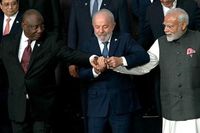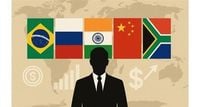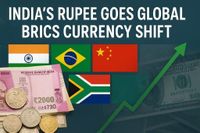The diplomatic relationship between the United States and Brazil has reached its lowest point in decades, with a dramatic series of events in June 2024 escalating simmering tensions into a high-stakes confrontation. In just one week, retaliatory sanctions, fierce accusations, and a sweeping tariff hike transformed what had been manageable disagreements into a full-blown crisis, drawing in global powers and forcing alliances to shift in real time.
The United States fired the opening salvo, taking several targeted actions that reverberated far beyond Washington and Brasília. The U.S. State Department abruptly canceled visas for several Brazilian health officials and relatives of Health Minister Alexandre Padilha, citing concerns about Brazil’s Mais Médicos program. According to Reuters, a U.S. official claimed anonymously on June 10, 2024, that the program exploited foreign doctors to support “authoritarian tendencies.” Brazil, for its part, vehemently rejected this characterization, maintaining that Mais Médicos is essential for providing public health services in underserved areas.
But the diplomatic drama didn’t end there. Just days later, the State Department released a highly politicized human rights report, departing from its usual technical tone to focus sharply on Brazil’s judicial handling of cases against former President Jair Bolsonaro and his supporters, all related to the fiercely contested 2022 election. The report, dated May 2024, accused Brazilian courts of “politically motivated prosecutions,” a claim that struck a nerve in Brasília and was widely perceived as an attack on Brazil’s sovereignty.
The most consequential blow, however, came from former U.S. President Donald Trump, who remains a dominant force in shaping current American foreign policy. Trump announced a sudden 50% tariff hike on key Brazilian exports—including steel, aluminum, and agricultural goods. He justified the move by pointing to Brazil’s high import tariffs—35% on cars, 20% on plastics, and 16% on auto parts—compared to lower U.S. rates. Trump framed Brazil as an unfair trading partner, despite the fact that, according to International Trade Commission data, the U.S. ran a $7 billion trade surplus with Brazil in 2023.
Brazilian President Luiz Inácio Lula da Silva wasted no time in responding. He swiftly activated diplomatic channels, seeking concrete backing from his fellow BRICS nations: Brazil, Russia, India, China, and South Africa. In a flurry of urgent calls, Lula rallied support from the leaders of China, Russia, and India. China, in particular, offered the strongest public endorsement. On June 12, 2024, a Chinese Foreign Ministry spokesperson declared, “China firmly opposes protectionism and unilateral sanctions. We stand with Brazil in safeguarding its legitimate rights and development path,” as reported by Xinhua News Agency. This statement signaled not only solidarity with Brazil but also Beijing’s intent to strengthen the BRICS bloc as a counterweight to U.S. influence.
Russia echoed similar sentiments. On June 11, 2024, TASS reported Moscow’s condemnation of “external interference” in Brazilian affairs. These gestures of support were more than symbolic—they underscored the growing importance of BRICS as a strategic platform for emerging economies to push back against Western dominance. In the words of Dr. Maria Silva, a Latin American geopolitics expert at the Wilson Center, “For Trump, this confrontation serves a crucial narrative. Portraying Lula’s Brazil as corrupt or authoritarian allows him to deflect from his own domestic legal challenges and position himself as democracy’s defender.”
For Lula, the crisis offered a different kind of political capital. “This crisis strengthens Lula’s hand against domestic far-right critics,” Silva explained. “It frames Brazil’s disputes within a larger struggle against Trumpism and Western dominance, rallying his base and international allies.” The standoff, therefore, isn’t just about trade or visas—it’s about leadership, influence, and the narrative of democracy itself.
The stakes are high, and the risks are real. China, eager to capitalize on the rift, could redirect significant agricultural purchases away from U.S. suppliers and toward Brazil, dealing a blow to American farmers. If Trump’s tariffs remain in place, they threaten to cripple key Brazilian export sectors, potentially costing thousands of jobs. Meanwhile, cooperation on critical transnational issues—from pandemic preparedness to regional security—has ground to a halt, as the two countries dig in their heels.
This diplomatic rupture comes at a time when BRICS is growing in both size and influence. Formed in 2009 as an informal coalition of emerging economies, BRICS now includes Egypt, Ethiopia, Iran, the United Arab Emirates, and Indonesia, with several other countries designated as partners. The bloc represents over a quarter of global GDP and nearly half of the world’s population, making it a formidable player in shaping global economic and political dynamics. BRICS aims to reform global governance, advocating for greater representation of emerging economies in institutions like the U.N. Security Council, and seeks to reduce reliance on the U.S. dollar by promoting trade in local currencies and exploring the idea of a common BRICS currency.
BRICS has also established alternative financial systems, such as the New Development Bank (NDB) and the Contingent Reserve Arrangement (CRA), providing infrastructure and development financing outside traditional Western channels. Despite internal divisions and differing national priorities—such as contrasting stances on Russia’s invasion of Ukraine—the bloc continues to attract countries in the Global South seeking alternatives to Western-dominated institutions.
The growing strength of BRICS has not gone unnoticed by Moscow. Following the Alaska summit with U.S. President Trump in 2025, Russian President Vladimir Putin personally reached out to leaders of India, Brazil, South Africa, and China. Each call reinforced Moscow’s commitment to multipolarity and the need to keep BRICS aligned as a counterbalance to Western influence. For Russia, BRICS now serves as a lifeline—offering economic markets, financial resilience, and political legitimacy in the face of ongoing sanctions and diplomatic isolation resulting from the Ukraine conflict.
“BRICS provides Russia with vast economic markets, a shield against Western-dominated globalization, and an alternative platform for asserting its interests,” noted a recent analysis. The bloc’s expansion and ambitions carry significant implications for global supply chains, commodity markets, and the strategic alignments of nations like Canada, which may need to recalibrate foreign policy and trade strategies in response to BRICS’ growing influence.
As the U.S.-Brazil crisis deepens, the world is witnessing a defining battle over influence in the Americas and the rules of global engagement. Both Washington and Brasília appear determined to hold their ground, with neither side showing much appetite for compromise. Trump leverages the conflict to energize his anti-globalist base, while Lula positions himself as a champion of the Global South, willing to defy U.S. pressure and strengthen alliances within BRICS. The result is a volatile, unpredictable standoff that threatens to disrupt not just bilateral relations but the broader architecture of global trade and diplomacy.
With both sides digging in, the U.S.-Brazil rupture is no longer just a story of tariffs or canceled visas. It’s become a test case for the future of multipolarity, the resilience of emerging alliances, and the ever-shifting balance of power in a world where old certainties are rapidly fading.


